I understand that sometimes it’s a good idea to get an idea of the infestation level of varroa mites in bee colonies. You can take samples from a couple of colonies in an apiary to get an idea when to treat. But my first concern is breeding varroa resistant bees.
I have never monitored the varroa infestation level in my colonies. I haven’t had time and I haven’t found any reason for it because I thought I had found a good compromise – treating with Thymol when I saw wingless bees on the hardboard in front of the hive entrance, checking every 10 days or so.
Good results up till now
I give a colony one or two pieces of dish wash cloth containing 5 grams of Thymol each when I see wingless bees crawling on the hard board in front of the hive. But this means I don’t treat every colony at the same time (hopefully some not at all in a season). This results in some colonies with higher mite loads not showing wingless bees yet. So these colony (-ies) will through reinvasion increase mite levels again quite quickly in those colonies recently treated.
But this way I’ve been able to develop more and more resistant bees and still produce a good crop. There have been a number of bees not producing any honey. Winter losses have been reduced from 30 % to 10-15 % (except the first year with varroa trouble when I lost 50 %).
The bees have been better chasing mites and remove infested brood. I’ve got good reports from for example Poland and Germany of low populations of varroa in colonies headed by Elgon queens, compared to other bees. And the VSH trait is becoming better and better. Daughters of my colony with the highest VSH % (80) gave colonies that in Poland dropped 2-5 mites after effective treatment while other colonies dropped more than 1000.
Thymol is useful but hinders total adaptation
I now have been aware that by having this regime I have a constant quite high varroa population in the apiaries as a whole, and thus probably a climbing virus pressure. In a way this is good as selection is done also on virus resistance.
How do I know that? Now when I’ve used the bee shaker somewhat this year I’ve seen that colonies may show wingless bees (DWV-virus) at low mite infestation. Such low infestation you didn’t expect them to do so, sometimes even as low as 2 % infestation (a daughter from a colony with high VSH trait [80%]! This experience and others similar, raise the question if very high VSH comes with higher susceptibility to viruses.). Wingless bees at 2 % infestation is totally different from a report I’ve got from a test further down in Europe. (There they normally treat effectively every year.) In that test where they didn’t treat at all, my bees didn’t show any wingless bees at 35% infestation while other bees had a lot.
How to explain the high infestation level in the test
Now I have to try to explain why my good bees could arrive at 35 % mite infestation. This is interesting and brings up another topic as well. The importance of memories of the worker bees (their knowledge how to chase mites), not only their genetics (and epigenetic history). My queens in this test down in Europe were introduced to bees that had not been selected the same way as mine, and those bees had been treated effectively every year. The bees could probably not chase mites as well as mine.
But of course the genetics from my queens would more and more influence the workers to build up a better behavior when it comes to chasing mites. When the bees have arrived at a good mite chasing mood they learn new bees born in the colony what they have achieved, more than what just come directly with the genetics. In Norway with Terje Reinertsen and Hans-Otto Johnsen experiences are achieved pointing strongly to this.
In an apiary where many colonies are non-resistant as in this European test, you get a mixture of all bees in the apiary through drifting and robbing. This is taking place more and more when the mite populations in the colonies rise. As it did in this test as the colonies were not treated at all.
In a situation when colonies are receiving a lot of mites from neighboring colonies, even the very best kind of mite chasing behavior is maybe not enough to keep mite levels low.
In the test apiary previous to this test, effective treating every year had kept the mite and virus levels low, so the mite population could grow much in the test without showing wingless bees – like in the beginning when the mite first arrives to an area. Then the virus levels are usually very low and there could be 10 000 mites and more in a colony without any signs of viruses (documented case in Sweden in 1987 when the mites were first detected on the island Gotland in the Baltic).
The bees in this test were on 5.5 mm cell size, while my bees are kept on 4.9 mm.
Also Thymol hinders total adaptation
I have talked to some beekeepers whose bees are totally treatment free since many years (Hans-Otto Johnsen in Norway, Richard Reid in Virginia and Myron Kropf in Arkansas). Their bees have now small populations of mites and are showing no wingless bees.
I have come to realize that also Thymol is a chemical that hinders the bees to fully adapt to handling the mites successfully on their own. It is in first place the epigenetic adaptation I have come to think of that is disturbed when alien chemicals (like miticides of all kinds) are present. Epigenetic changes take place when a chemical change occur due to environmental changes, like for example the presence of the mite. (But it should be said also that if you use Thymol regularly spring and late summer in a system not selecting better bees like I do, winter losses can be kept low. I know because beekeeper friends do like this.) Also Thymol like other miticides is lowering the immune system of the bees.
How do I then integrate these insights to go further in becoming totally treatment free?
A new strategy to try
I’m planning a new strategy, at least to start with in one quite isolated apiary. I have to stop using Thymol. First though I think I have to knock down the mites effectively to reduce the virus level. And then get a better control of the number of mites and take action without any chemicals if varroa populations are rising too much in colonies.
The role of the bee shaker
Here the bee shaker will play a role. And I have looked more into how Randy Oliver uses it. It’s much easier to shake a frame of bees into a bowl or pan and then with a measuring cup scope somewhat more than a deciliter (3.5 oz) of bees and pour them into one half of the bee shaker, half filled with alcohol (for example methylated spirit or rubbing[isopropyl] alcohol). Then screw it together and shake for a minute before reading the result. Compared to holding the bee shaker close to a frame side with bees and pour bees into it moving it slowly upwards, the alternative of Randy Oliver is quicker (at least for me). The next step is to test the VSH trait in the best colonies.
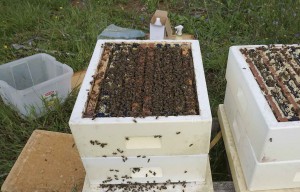 Start checking from one side in the uppermost box with brood. The queen hopefully will run to the brood if she is outside the brood area (probably not). The comb closest to brood you check so the queen is not there.
Start checking from one side in the uppermost box with brood. The queen hopefully will run to the brood if she is outside the brood area (probably not). The comb closest to brood you check so the queen is not there.
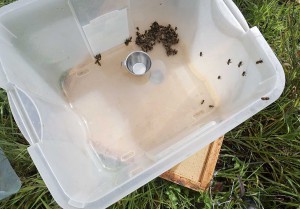 Shake the bees into a pan or bowl. Scope up somewhat more than a deciliter of bees (3.5 oz)
Shake the bees into a pan or bowl. Scope up somewhat more than a deciliter of bees (3.5 oz)
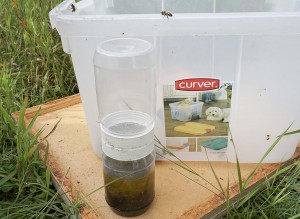 Pour the bees into one of the halfs of the bee shaker, which is half filled with alcohol. Screw the other half tight on top. Shake it for a minute.
Pour the bees into one of the halfs of the bee shaker, which is half filled with alcohol. Screw the other half tight on top. Shake it for a minute.
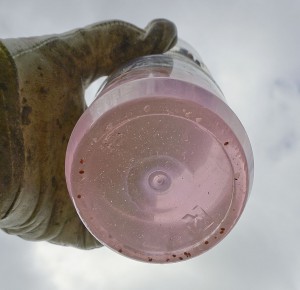 Turn the shaker upside down and continue shaking until all the alcohol has poured down. Lift it up against the sky and count the mites. This colony had 14 mites on 300 mites and it got two pieces with 5 gram Thymol each. It showed no wingless bees.
Turn the shaker upside down and continue shaking until all the alcohol has poured down. Lift it up against the sky and count the mites. This colony had 14 mites on 300 mites and it got two pieces with 5 gram Thymol each. It showed no wingless bees.
What I hated to do
So what I’ve done so far is something I hated to do. In one quite isolated apiary I used an effective chemical miticide (only this time I promised myself) in August 2015. I wanted to use something else than Thymol to give the bees a break from that chemical. And I wanted to knock down the mite population effectively to lower the virus pressure in the apiary. I collected the knocked down mites. (In the rest of the apiaries I plan at the moment to continue as before.) The colonies that had needed most Thymol earlier in the season had the highest downfall of mites. They got probably continuously reinfested from other colonies that happened to not show wingless bees while they anyway had quite high mite loads. The defense system of these quickly reinfested colonies was probably lowered by Thymol, which made this relatively quick reinfestation possible.
One colony that hadn’t needed any Thymol at all (and very little the year before) and still had given me 80 kg (175 lb) of honey with 20 kg (45 lb) left for winter dropped less than 200 mites. And this happened in this very bad season of 2015. This colony is of course a breeder for the coming season.
The new strategy
Next year I will in this new strategy apiary make splits from the best colonies and place them in the same apiary (or if the number is enough there, place in other apiaries). In the least good colonies in this apiary (those with highest infestation level) I will kill the queen and give them a ripe queen cell bred from a good colony in this apiary. I check the number of varroa (infestation level) with the bee shaker twice a season in all colonies in this apiary. Each time it will take about 5 minutes per colony. And I look for eventual wingless bees on the hard board in front of the entrances. Before the number of mites rise too high (whatever that is), or when I see wingless bees, I plan to remove all capped brood (worker and drone brood) once or twice with a week in between. I haven’t decided what to do with those brood frames yet. Any suggestion?
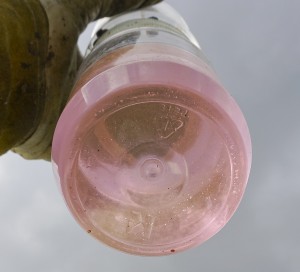
Erik, Very interesting analysis on several levels. Do you think putting the new treatment free apiary in an area where there are no (or very few) treated bees would help in setting the genetics for that apiary’s bees? In a sense dominating the local genetics with your best treatment free genetics. But I wonder if some mite or virus load is helpful in keeping mite resistant traits set in the population. The latter may be a mute point since mites should be present in most areas.
Yes Richard, I think it’s helps a lot to have the treatment free apiary on its own as much as possible. When the adaptation is “complete” (or better) the bees can handle a more difficult reinvasion situation better, and even a situation with more “alien” genetic influence.
And yes, if this treatment free apiary is very isolated and will never have any new mites coming in from outside, no reinvasion at all, eventually the mites will almost or maybe even totally eradicated as Apis mellifera small cell honeybees very effectively can also detect and clean out infested drone brood (as Apis cerana can’t as the drone cappings there are too hard). Naturally drawn drone cell size is bigger too i large cell colonies and are much more difficult for the bees to detect mites in, or at least clean out the mites from. Johnsen in Norway has done a lot of tests with that.
Yes, if the bees in an isolated apiary get rid of the mites or handle the mites very effectively so the mite population never reaches more than a very low level, the bees don’t need a very effective mite defense, it doesn’t have to be more than good enough then, not perfect (as with a big reinvasion). So there wouldn’t be a hard selection for varroa resistance, just good enough for that situation. So if a lot of large cell treated colonies with a lot of virus filled mites will come into the area, the varroa resistant local bees will be having a hard time.
So when you have reached a perfect situation of low level mite population in your bees, which you have, I guess it’s an interesting idea to look for a package with mite and virus filled bees to give your bees some selection help… But I guess no one would answer an ad for such bees.:)
Dear Eric,
you said that you try to get rid of any miticides, (e.g. thymol). I agree with you that miticides are temporary solution, because at one day mites will adopt to it (and maybe have adopted already somehow), secondly, bees get affected by miticides (which will affect their defense reactions more or less) and thirdly, you want to achieve completely resistant bees.
BTW, I have heard that the correlation between phoretic and mites in brood is in some areas, not 30 : 70% anymore instead 15 : 85% (e.g. Spain). This is also said for some powdered sugar users. Ask Stephan Braun, who gave this information, if you want the correct source. This might be a nice example, how mites adopt on contact miticides, when treated long enough. The ones that decrease phoretic time and move faster towards brood will be positively selected in such schemes…
If I remember correctly you indicate earlier that apiaries that are not treated should be isolated and that at least 80% of the hives should have the ability to withstand mites significantly. Of course the danger is, that you loose in the first year the hives that are not well adapted, but on the other hand, you allow colonies to react on epigenetic stimuli (increased mite levels) more adequate, with the chance that these bees learn how to deal with mites efficiently. On the other hand bee genetic which is not resistant, doesn’t play a role in mating next year, what should be a considerable advantage as well.
Then you addressed the point how to monitor the defense situation of hives in question, in order to react, when mite numbers seem to be out of control. That’s the point I want to drop in and discuss what I intend to do in order to manage this challenge:
I use natural mite fall counts in order to get an impression about the resistance status (additionally to DWV bee count, hygienic behaviour count and overall situation). The advantage is, you do not need to disturb the hive. The disadvantage you need several countings in order to get an reliable picture. I know that several people argue against natural mite fall. Basically their main argument against is, one cannot distinguish between hives that have high levels of VSG (varroa resistant grooming) and hives that doesn’t have. This is of course a valid argument in the first glance. However, as said could be balanced out by doing several mite counts over a longer period. Here the hives that have sufficient amounts of VSG should be detected, because after clearance of mites, the natural mite fall should decrease and only increase if mite levels are higher again. With other words, if mite levels are changing, this is a sign of resistant active hive and actually a good sign. Hives with constant low levels are of course the cherries, one have to pick. And hives that have constantly increasing mite levels, need to be requeened. Hives that struggle and seem to maintain a certain (high) mite level are the ones that need to be observed, which is especially true end of season or in heavy mite seasons.
The only drawback is, that I cannot use this method in my apiaries away from my home, as time is not sufficient, as you need to control these levels at least 2-3 times/month starting from July/August.
Thanks Rüdiger for your analysis. I agree. The drawback of your method is the reason why I’m not able to use it.
Interesting info about the changing ratio of phoretic and mites in brood for colonies treated with powdered sugar.
Concerning VSG I had got reports from colonies with Johnsen which in late summer in preparation for winter eradicated the mite population, natural downfall increased strongly for some time followed by zero downfall.
Mr Österlund,
If I understood correctly You want to use miticide for lowering varroa and virus pressure of Your apiaries in the begining of the “new strategy”, to give bees more chance of surviving… Or only in some of the collonies?
Since Your goal is becoming completly treatment free, my opinion is that taking off those pressures will be step back. This is the only pressure that keeps the selection going forward.
The other thing is the importance of hive micro and macro flora and fauna. I think the healty bacteria and fungus are the key to the bees’ resistance against viruses and other pathogens (Mr Bush on the subject: http://www.bushfarms.com/beesnotreatments.htm). I also think whatever You do, You will not be able to remove viruses from Your apiary. Even if the strategy of lowering virus pressure works, the only thing You will accomplish is postponing the selection for a year or so.
Since Your bees have enormous chance of surviving as opposed to most of the other bees all around I would thing that on this stage of breeding operation “Expansion Model Beekeeping” may be the answer … (http://www.beesource.com/forums/showthread.php?279799-Expansion-Model-Beekeeping).
…but I might have misunderstood something (because of language issues).
I’m following Your blog for some time. I also have some of Your bees’s granddaughters since this year. I hope, whatever You do brings You closer to the goal.
Bartek, Poland.
Thanks Bartek for interesting comments. I think you understood me correctly.
We’ll see what happens with my new strategy. I think I have to try a new one at this point in one apiary which is quite isolated. I start with only one apiary. But all of the colonies in that apiary. The reason I am thinking as I do is twofold. Early on in about 1997 a beekeeper who used an effective chemical miticide every year got 5 queens from me and introduced them in 5 of his colonies and placed those in isolated apiary. And they were on large cells, not small. He hasn’t used any treatment in that apiary since, except a couple of colonies for two years that showed wingless bees. Those two colonies were not Elgons but Primorski X Elgon. He sometimes got new queens from me during the years and colonies were allowed to shift queens themselves. At the most the number of colonies were eight I think. Winterlosses were few but existed. Crop was normal. Today the beekeeper is old the apiary is not in use any more.
My point is that he started this apiary when the virus load in bees in this area was low. Mites arrived about 1991-2.
Another reason for trying this strategy is my observation that bees actively get rid of bees with signs of viruses. They are thrown out of the hive. The bees are lowering virus load this way apparently. And mites are vectors of viruses, they bite hole in the exoskeleton and viruses get into the bee from the mite. Viruses reproduce in mites as well as in the bees. So getting rid of mites will reduce virus pressure in the colony and infect less number of bees with virus.
But as you write all kinds of chemicals affect the microfauna and thus the immune or defense system of the bees is lowered. That’s one reason why I want to stop all treatment. Why I didn’t do that at once when mites arrived is because then I had lost at least 90 % of my bees and hadn’t had enough bees to dominate my area and had lost food on the table. The strategy I have used up till now is a compromise.
Let’s say the virus pressure is lowered in the new strategy apiary. The way it will stay lower than compared to now is that I will not allow mite levels to rise as up till now. I will keep track of the mite level through alcohol wash and remove all capped brood and shift queen. And I will increase number of hives through splitting the best/strongest/most resistant. That way the less good bees will be reduced and the good ones increased.
Good luck with your new queens.